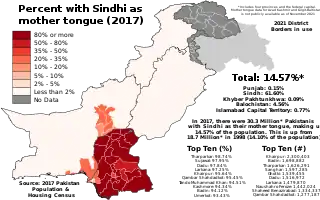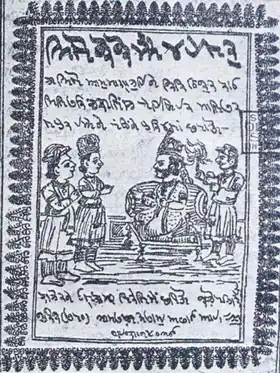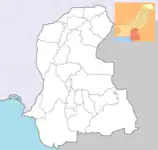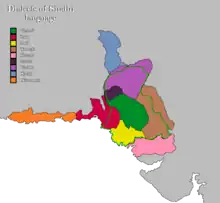Sindhi language
Sindhi (English pronunciation: /ˈsɪndi/;[4] Sindhi: سِنڌِي (Perso-Arabic); सिन्धी (Devanagari); Sindhi pronunciation: [sɪndʱiː]) is an Indo-Aryan language spoken by about 30 million people in the Pakistani province of Sindh, where it has official status. It is also spoken by a further 1.7 million people in India, where it is a scheduled language, without any state-level official status. The main writing system is the Perso-Arabic script, which accounts for the majority of the Sindhi literature and is the only one currently used in Pakistan. In India, both the Perso-Arabic script and Devanagari are used.
| Sindhi | |
|---|---|
| Sindhī | |
| سِنڌِي • सिन्धी | |
  Sindhi written in Perso-Arabic script (above) and Devanagari (below) | |
| Native to | Pakistan, India |
| Region | Sindh and near the border in neighbouring regions (e.g. Kutch and Balochistan) |
| Ethnicity | Sindhis |
Native speakers | c. 32 million (2011–2017)[1] |
| |
| Official status | |
Official language in | |
| Regulated by |
|
| Language codes | |
| ISO 639-1 | sd |
| ISO 639-2 | snd |
| ISO 639-3 | snd |
| Glottolog | sind1272 Sindhi |
| Linguasphere | 59-AAF-f |
 The proportion of people with Sindhi as their mother tongue in each Pakistani District as of the 2017 Pakistan Census | |
 Sindhi is not in the category of endangered according to the classification system of the UNESCO Atlas of the World's Languages in Danger | |
| Part of a series on | |
|---|---|
| |
| Constitutionally recognised languages of India | |
| Category | |
| 22 Official Languages of the Indian Republic | |
| Related | |
Sindhi has an attested history from the 10th century CE. Sindhi was one of the first Indo-Aryan languages to encounter influence from Persian and Arabic following the Umayyad conquest in 712 CE. A substantial body of Sindhi literature developed during the Medieval period, the most famous of which is the religious and mystic poetry of Shah Abdul Latif Bhittai from the 18th century. Modern Sindhi was promoted under British rule beginning in 1843, which led to the current status of the language in independent Pakistan after 1947.
History

| Part of a series on |
| Sindhis |
|---|
 |
 Sindh portal |
Origins
The name "Sindhi" is derived from the Sanskrit síndhu, the original name of the Indus River, along whose delta Sindhi is spoken.[5]
Like other languages of the Indo-Aryan family, Sindhi is descended from Old Indo-Aryan (Sanskrit) via Middle Indo-Aryan (Pali, secondary Prakrits, and Apabhramsha). 20th century Western scholars such as George Abraham Grierson believed that Sindhi descended specifically from the Vrācaḍa dialect of Apabhramsha (described by Markandeya as being spoken in Sindhu-deśa, corresponding to modern Sindh) but later work has shown this to be unlikely.[6]
Early Sindhi (10th–16th centuries)
Literary attestation of early Sindhi is sparse. Historically, Isma'ili religious literature and poetry in India, as old as the 11th century CE, used a language that was closely related to Sindhi and Gujarati. Much of this work is in the form of ginans (a kind of devotional hymn).[7][8]
Sindhi was the first Indo-Aryan language to be in close contact with Arabic and Persian following the Umayyad conquest of Sindh in 712 CE. According to Sindhi tradition, the first translation of the Quran into Sindhi was initiated in 883 CE in Mansura, Sindh. This is corroborated by the accounts of Al-Ramhormuzi but it is unclear whether the language of translation was actually a predecessor to Sindhi, nor is the text preserved.[9]
Medieval Sindhi (16th–19th centuries)
Medieval Sindhi literature is of a primarily religious genre, comprising a syncretic Sufi and Advaita Vedanta poetry, the latter in the devotional bhakti tradition. The earliest known Sindhi poet of the Sufi tradition is Qazi Qadan (1493–1551). Other early poets were Shah Inat Rizvi (c. 1613–1701) and Shah Abdul Karim Bulri (1538–1623). These poets had a mystical bent that profoundly influenced Sindhi poetry for much of this period.[7]
Another famous part of Medieval Sindhi literature is a wealth of folktales, adapted and readapted into verse by many bards at various times and possibly much older than their earliest literary attestations. These include romantic epics such as Sassui Punnhun, Sohni Mahiwal, Momal Rano, Noori Jam Tamachi, Lilan Chanesar, and others.[10]
The greatest poet of Sindhi was Shah Abdul Latif Bhittai (1689/1690–1752), whose verses were compiled into the Shah Jo Risalo by his followers. While primarily Sufi, his verses also recount traditional Sindhi folktales and aspects of the cultural history of Sindh.[7]
The first attested Sindhi translation of the Quran was done by Akhund Azaz Allah Muttalawi (1747–1824) and published in Gujarat in 1870. The first to appear in print was by Muhammad Siddiq in 1867.[11]
Modern Sindhi (1843–present)
Sindh was occupied by the British army and was annexed with the Bombay Presidency in 1843. Soon after, in 1848, Governor George Clerk established Sindhi as the official language in the province, removing the literary dominance of Persian. Sir Bartle Frere, the then commissioner of Sindh, issued orders on August 29, 1857, advising civil servants in Sindh to pass an examination in Sindhi. He also ordered the use of Sindhi in official documents.[12] In 1868, the Bombay Presidency assigned Narayan Jagannath Vaidya to replace the Abjad used in Sindhi with the Khudabadi script. The script was decreed a standard script by the Bombay Presidency thus inciting anarchy in the Muslim majority region. A powerful unrest followed, after which Twelve Martial Laws were imposed by the British authorities. The granting of official status of Sindhi along with script reforms ushered in the development of modern Sindhi literature.
The first printed works in Sindhi were produced at the Muhammadi Press in Bombay beginning in 1867. These included Islamic stories set in verse by Muhammad Hashim Thattvi, one of the renowned religious scholars of Sindh.[10]
The Partition of India in 1947 resulted in most Sindhi speakers ending up in the new state of Pakistan, commencing a push to establish a strong sub-national linguistic identity for Sindhi. This manifested in resistance to the imposition of Urdu and eventually Sindhi nationalism in the 1980s.[13]
The language and literary style of contemporary Sindhi writings in Pakistan and India were noticeably diverging by the late 20th century; authors from the former country were borrowing extensively from Urdu, while those from the latter were highly influenced by Hindi.[14]
Geographic distribution
In Pakistan, Sindhi is the first language of 30.26 million people, or 14.6% of the country's population as of the 2017 census. 29.5 million of these are found in Sindh, where they account for 62% of the total population of the province. There are 0.56 million speakers in the province of Balochistan,[15] especially in the Kacchi Plain that encompasses the districts of Lasbela, Hub, Kachhi, Sibi, Sohbatpur, Jafarabad, Jhal Magsi, Usta Muhammad and Nasirabad.
In India, Sindhi mother tongue speakers were distributed in the following states:
| State | Population |
|---|---|
| Gujarat | 1,184,024 |
| Maharashtra | 723,748 |
| Rajashtan | 386,569 |
| Madhya Pradesh | 245,161 |
| Chattisgarh | 93,424 |
| Delhi (NCT) | 31,177 |
| Uttar Pradesh | 28,952 |
| Assam | 19,646 |
| Karnataka | 16,954 |
| Andhra Pradesh | 11,299 |
| Tamil Nadu | 8,448 |
| West Bengal | 7,828 |
| Uttarakhand | 2,863 |
| Odisha | 2,338 |
| Bihar | 2,227 |
| Jharkhand | 1,701 |
| Haryana | 1,658 |
| Kerala | 1,251 |
| Punjab | 754 |
| Goa | 656 |
| Dadra and Nagar | 894 |
| Meghalaya | 236 |
| Chandigarh | 134 |
| Puducherry | 94 |
| Nagaland | 82 |
| Himachal Pradesh | 62 |
| Tripura | 30 |
| Jammu and Kashmir | 19 |
| Andaman and Nicobar Islands | 14 |
| Arunachal Pradesh | 12 |
| Lakshadweep | 7 |
| Sikkim | 2 |
Official status
Sindhi is the official language of the Pakistani province of Sindh[17][3] and one of the scheduled languages of India, where it does not have any state-level status.[18]
Prior to the inception of Pakistan, Sindhi was the national language of Sindh.[19][20][21][22] The Pakistan Sindh Assembly has ordered compulsory teaching of the Sindhi language in all private schools in Sindh.[23] According to the Sindh Private Educational Institutions Form B (Regulations and Control) 2005 Rules, "All educational institutions are required to teach children the Sindhi language.[24] Sindh Education and Literacy Minister, Syed Sardar Ali Shah, and Secretary of School Education, Qazi Shahid Pervaiz, have ordered the employment of Sindhi teachers in all private schools in Sindh so that this language can be easily and widely taught.[25] Sindhi is taught in all provincial private schools that follow the Matric system and not the ones that follow the Cambridge system.[26]
At the occasion of 'Mother Language Day' in 2023, the Sindh Assembly under Culture minister Sardar Ali Shah, passed a unanimous resolution to extend the use of language to primary level[27] and increase the status of Sindhi as a national language[28][29][30] of Pakistan.
The Indian Government has legislated Sindhi as a scheduled language in India, making it an option for education. Despite lacking any state-level status, Sindhi is still a prominent minority language in the Indian state of Rajasthan.[31]
There are many Sindhi language television channels broadcasting in Pakistan such as Time News, KTN, Sindh TV, Awaz Television Network, Mehran TV, and Dharti TV.
Dialects

Sindhi has many dialects, and forms a dialect continuum at some places with neighboring languages such as Saraiki and Gujarati. Some of the documented dialects of Sindhi are:[32][33][34][35][36]
- Vicholi: The prestige dialect spoken around Hyderabad and central Sindh (the Vicholo region). The literary standard of Sindhi is based on this dialect.
- Uttaradi: The dialect of northern Sindh (Uttaru, meaning "north"), with small differences in Larkana, Shikarpur and in parts of Sukkur and Kandiaro.[37]
- Lari: The dialect of southern Sindh (Lāṛu) spoken around areas like Karachi, Thatta, Sujawal and Badin.
- Siroli/Siraiki or Ubheji: The dialect of northernmost Sindh (Siro, meaning "head").[38] Spoken in all over Sindh but majority is in Jacobabad and Kashmore, it has little similarity with the Saraiki language of South Punjab[39] and has variously been treated either as a dialect of Saraiki or as a dialect of Sindhi.[40]
- Lasi: The dialect of Lasbela, Hub and Gwadar districts in Balochistan, closely related to Lari and Vicholi, and in contact with Balochi.
- Firaqi Sindhi: The dialect of the Kachhi plains the north eastern districts of Balochistan, where it is referred to as Firaqi Sindhi or commonly just Sindhi.[41]
- Sindhi Bhil: It is a dialect spoken in Sindh by the Meghwars and Bheels.[42] Sindhi Bhil is known to have many old Sindhi words, which were lost after Arabic, Persian, and Chaghatai influence.[43][44]
The variety of Sindhi spoken by Sindhi Hindus who emigrated to India is known as Dukslinu Sindhi. Furthermore, Kutchi and Jadgali are sometimes classified as dialects of Sindhi rather than independent languages.
Grammar
Phonology
Sindhi has a relatively large inventory of both consonants and vowels compared to other Indo-Aryan languages.[45] Sindhi has 46 consonant phonemes and 10 vowels.[46] The consonant to vowel ratio is around average for the world's languages at 2.8.[47] All plosives, affricates, nasals, the retroflex flap, and the lateral approximant /l/ have aspirated or breathy voiced counterparts. The language also features four implosives.
Consonants
| Labial | Dental/ alveolar |
Retroflex | (Alveolo-) Palatal |
Velar | Glottal | ||||||||
|---|---|---|---|---|---|---|---|---|---|---|---|---|---|
| Nasal | plain | m م | n ن | ɳ ڻ | ɲ ڃ | ŋ ڱ | |||||||
| breathy | mʱ مھ | nʱ نھ | ɳʱ ڻھ | ||||||||||
| Stop/ Affricate |
plain | p پ | b ب | t̪ ت | d̪ د | ʈ ٽ | ɖ ڊ | tɕ چ | dʑ ج | k ڪ | ɡ گ | ||
| breathy | pʰ ڦ | bʱ ڀ | t̪ʰ ٿ | d̪ʱ ڌ | ʈʰ ٺ | ɖʱ ڍ | tɕʰ ڇ | dʑʱ جھ | kʰ ک | ɡʱ گھ | |||
| Implosive | ɓ ٻ | ɗ ڏ | ʄ ڄ | ɠ ڳ | |||||||||
| Fricative | f ف | s س | z ز | ʂ ش | x خ | ɣ غ | h ھ | ||||||
| Approximant | plain | ʋ و | l ل | j ي | |||||||||
| breathy | lʱ لھ | ||||||||||||
| Rhotic | plain | r ر | ɽ ڙ | ||||||||||
| breathy | ɽʱ ڙھ | ||||||||||||
The retroflex consonants are apical postalveolar and do not involve curling back of the tip of the tongue,[49] so they could be transcribed [t̠, t̠ʰ, d̠, d̠ʱ n̠ n̠ʱ ɾ̠ ɾ̠ʱ] in phonetic transcription. The affricates /tɕ, tɕʰ, dʑ, dʑʱ/ are laminal post-alveolars with a relatively short release. It is not clear if /ɲ/ is similar, or truly palatal.[50] /ʋ/ is realized as labiovelar [w] or labiodental [ʋ] in free variation, but is not common, except before a stop.

Vowels
| Front | Central | Back | |
|---|---|---|---|
| Close | i | u | |
| Near-close | ɪ | ʊ | |
| Close-mid | e | o | |
| Mid | ə | ||
| Open-mid | æ | ɔ | |
| Open | ɑ |
The vowels are modal length /i e æ ɑ ɔ o u/ and short /ɪ ʊ ə/. Consonants following short vowels are lengthened: /pət̪o/ [pət̪ˑoː] 'leaf' vs. /pɑt̪o/ [pɑːt̪oː] 'worn'.
Nouns
Sindhi nouns distinguish two genders (masculine and feminine), two numbers (singular and plural), and five cases (nominative, vocative, oblique, ablative, and locative). This is a similar paradigm to Punjabi. Almost all Sindhi noun stems end in a vowel, except for some recent loanwords. The declension of a noun in Sindhi is largely determined from its grammatical gender and the final vowel (or if there is no final vowel). Generally, -o stems are masculine and -a stems are feminine, but the other final vowels can belong to either gender.
The different paradigms are listed below with examples.[51] The ablative and locative cases are used with only some lexemes in the singular number and hence not listed, but predictably take the suffixes -ā̃ / -aū̃ / -ū̃ (ABL) and -i (LOC).
| SG | PL | Gloss | ||||||
|---|---|---|---|---|---|---|---|---|
| NOM | VOC | OBL | NOM | VOC | OBL | |||
| M | I | ڇوڪِرو chokiro |
ڇوڪِرا chokirā |
ڇوڪِري chokire |
ڇوڪِرا chokirā |
ڇوڪِرا / ڇوڪِرَ chokirā / chokira |
ڇوڪِرَنِ chokirani |
boy |
| II | ٻارُ ɓāru |
ٻارَ ɓāra |
ٻارو / ٻارَ ɓāra / ɓāro |
ٻارَنِ ɓārani |
child | |||
| III | ساٿِي sāthī |
ساٿِيءَ sāthīa |
ساٿِي sāthī |
ساٿيو sāthyo |
ساٿيُنِ sāthyuni |
companion | ||
| رَھاکُو rahākū |
رَھاکُوءَ rahākūa |
رَھاکُو rahākū |
رَھاکُئو rahākuo |
رَھاکُنِ rahākuni |
inhabitant | |||
| IV | راجا rājā |
راجا / راجائُون rājā / rājāū̃ |
راجائُنِ rājāuni |
king | ||||
| سيٺِ seṭhi |
سيٺِ / سيٺيُون seṭhi / seṭhyū̃ |
سيٺيُنِ seṭhyuni |
merchant | |||||
| F | I | زالَ zāla |
زالُون zālū̃ |
زالُنِ zāluni |
woman, wife | |||
| سَسُ sasu |
سَسُون sasū̃ |
سَسُنِ sasuni |
mother-in-law | |||||
| II | دَوا davā |
دَوائُون davāū̃ |
دَوائُنِ davāuni |
medicine | ||||
| راتِ rāti |
راتيُون rātyū̃ |
راتيُنِ rātyuni |
night | |||||
| هوٽَل hoṭal |
هوٽَلُون hoṭalū̃ |
هوٽَلُنِ hoṭaluni |
hotel | |||||
| III | ڳَئُون ɠaū̃ |
ڳَئُونَ ɠaū̃a |
ڳَئُون ɠaū̃ |
ڳَئُونِ ɠaūni |
cow | |||
| IV | نَدِي nadī |
نَدِيءَ nadīa |
نَديُون nadyū̃ |
نَديُنِ nadyuni |
river | |||
A few nouns representing familial relations take irregular declensions with an extension in -r- in the plural. These are the masculine nouns ڀاءُ bhāu "brother", پِيءُ pīu "father", and the feminine nouns ڌِيءَ dhīa "daughter", نُونھَن nū̃hã "daughter-in-law", ڀيڻَ bheṇa "sister", ماءُ māu "mother", and جوءِ joi "wife".[51]
| SG | PL | Gloss | |||||
|---|---|---|---|---|---|---|---|
| NOM | VOC | OBL | NOM | VOC | OBL | ||
| M | ڀاءُ bhāu |
ڀائُرُ / ڀائُرَ bhāuru / bhāura |
ڀائُرَ / ڀائُرو bhāura / bhāuro |
ڀائُرَنِ / ڀائُنِ bhāurani / bhāuni |
brother | ||
| F | ڌِيءَ / ڌِيءُ dhīa / dhīu |
ڌِيئَرُ / ڌِيئَرُون / ڌِيئُون dhīaru / dhīarū̃ / dhīū̃ |
ڌِيئَرُنِ / ڌِيئُنِ dhīaruni / dhīuni |
daughter | |||
Personal pronouns
Like other Indo-Aryan languages, Sindhi has first and second-person personal pronouns as well as several types of third-person proximal and distal demonstratives. These decline in the nominative and oblique cases. The genitive is a special form for the first and second-person singular, but formed as usual with the oblique and case marker جو jo for the rest. The personal pronouns are listed below.[52]
| SG | PL | |||||
|---|---|---|---|---|---|---|
| 1 | 2 | 1 | 2 | |||
| NOM | مَان / آئُون mā̃ / āū̃ |
تُون tū̃ |
اَسِين asī̃ |
تَوِهِين tavhī̃ | ||
| OBL | مُون mū̃ |
تو to |
اَسَان asā̃ |
تَوِهَان tavhā̃ | ||
| GEN | مُنهِنجو mũhinjo |
تُنهِنجو tũhinjo |
— | |||
The third-person pronouns are listed below. Besides the unmarked demonstratives, there are also "specific" and "present" demonstratives. In the nominative singular, the demonstratives are marked for gender. Some other pronouns which decline identically to ڪو ko "someone" are هَرڪو har-ko "everyone", سَڀڪو sabh-ko "all of them", جيڪو je-ko "whoever" (relative), and تيڪو te-ko "that one" (correlative).[52]
| Demonstrative | Interrogative | Relative | Correlative | |||||||||
|---|---|---|---|---|---|---|---|---|---|---|---|---|
| Unmarked | Specific | Present | Indefinite | |||||||||
| PROX | DIST | PROX | DIST | PROX | DIST | |||||||
| SG | NOM | M | هِي hī |
هُو hū |
اِهو iho |
اُهو uho |
اِجهو ijho |
اوجهو ojho |
ڪو ko |
ڪيرُ keru |
جو jo |
سو so |
| F | هِيءَ hīa |
هُوءَ hūa |
اِهَا ihā |
اُهَا uhā |
اِجهَا ijhā |
اوجهَا ojhā |
ڪَا kā |
ڪيرَ kera |
جَا jā |
سَا sā | ||
| OBL | هِنَ hina |
هُنَ huna |
اِنهين inhẽ |
اُنهين unhẽ |
— | ڪَنهِن kãhĩ |
جَنهِن jãhĩ |
تَنهِن tãhĩ | ||||
| PL | NOM | هِي hī |
هُو hū |
اِهي ihe |
اُهي uhe |
اِجهي ijhe |
اوجهي ojhe |
ڪي ke |
ڪيرَ kera |
جي je |
سي se | |
| OBL | هِنَنِ hinani |
هُنَنِ hunani |
اِنهَنِ inhani |
اُنهَنِ unhani |
— | ڪِنِ kini |
جِنِ jini |
تنِ tini | ||||
Numerals
|
| ||||||||||||||||||||||||||||||||||||||||||||||||||||||||||||||||||
Postpositions
Most nominal relations (e.g. the semantic role of a nominal as an argument to a verb) are indicated using postpositions, which follow a noun in the oblique case. The subject of the verb takes the bare oblique case, while the object may be in nominative case or in oblique case and followed by the accusative case marker کي khe.[53]
The postpositions are divided into case markers, which directly follow the noun, and complex postpositions, which combine with a case marker (usually the genitive جو jo).
Case markers
The case markers are listed below.[53]: 399
The postpositions with the suffix -o decline in gender and number to agree with their governor, e.g. ڇوڪِرو جو پِيءُ chokiro j-o pīu "the boy's father" but ڇوڪِر جِي مَاءُ chokiro j-ī māu "the boy's mother".
| Case | Marker | Example | English |
|---|---|---|---|
| Nominative | — | ڇوڪِرو chokiro | the boy |
| Accusative Dative |
کي khe |
ڇوڪِري کي chokire khe |
the boy to the boy |
| Genitive | جو j-o | ڇوڪِري جو chokire jo |
of the boy |
| سَندو sand-o | ڇوڪِري سَندو chokire sando | ||
| Sociative | سُڌو sudh-o | ڇوڪِري سُڌو chokire sudho | along with the boy |
| Comitative Instrumental |
سَان sā̃ | ڇوڪِري سَان chokire sā̃ |
with the boy |
| سَاڻُ sāṇu | ڇوڪِري سَاڻُ chokire sāṇu | ||
| Locative | ۾ mẽ | ڇوڪِري ۾ chokire mẽ |
in the boy |
| مَنجهِ manjhi | ڇوڪِري مَنجهِ chokire manjhi | ||
| Adessive | تي te | ڇوڪِري تي chokire te | on the boy |
| وَٽِ vaṭi | ڇوڪِري وَٽِ chokire vaṭi | near the boy the boy has... | |
| Orientative | ڏَانهَن ḍā̃hã | ڇوڪِري ڏَانهَن chokire ḍā̃hã | towards the boy |
| Terminative | تَائيِن tāī̃ | ڇوڪِري تَائيِن chokire tāī̃ | up to the boy |
| Benefactive | لاءِ lāi | ڇوڪِري لاءِ chokire lāi | for the boy |
| Semblative | وَانگُرُ vānguru | ڇوڪِري وَانگُرُ chokire vānguru |
like the boy |
| جَهڙو jahṛ-o | ڇوڪِري جَهڙو chokire jahṛo |
There are several ablative case markers formed from the spatial postpositions and the ablative ending -ā̃. These indicate complex motion such as "from inside of".[53]: 400
| Marker | Example | English |
|---|---|---|
| کَان khā̃ | ڇوڪِري کَان chokire khā̃ | from the boy |
| مَان mā̃ | ڇوڪِري مَان chokire mā̃ | from inside the boy |
| تَان tā̃ | ڇوڪِري تَان chokire tā̃ | from upon the boy |
| ڏَانهَان ḍā̃hā̃ | ڇوڪِري ڏَانهَان chokire ḍā̃hā̃ | from the direction of the boy |
Finally, some case markers are found in medieval Sindhi literature and/or modern poetic Sindhi, and otherwise not used in standard speech.
| Case | Marker | Example | English |
|---|---|---|---|
| Accusative Adessive | ڪَني kane | ڇوڪِري ڪَني chokire kane | to/near the boy |
Complex postpositions
The complex postpositions are formed with a case marker, usually the genitive but sometimes the ablative. Many are listed below.[53]: 405
| Sindhi | Transliteration | Explanation |
|---|---|---|
| جي اَڳيَان | je aɠyā̃ | "ahead of, before"; apudessive |
| جي اَندَرِ | je andari | "inside of"; inessive |
| جي بَدِرَان | je badirā̃ | "instead of, in place of" |
| جي بَرَابَر | je barābar | "equal to" |
| جي ٻَاهَرَان | je ɓāharā̃ | "outside of" |
| کَان ٻَاهَرِ | khā̃ ɓāhari | |
| جي باري ۾ | je bāre mẽ | "about, concerning" |
| جي چَوڌَارِي | je caudhārī | "around" |
| جي هيٺَان | je heṭhā̃ | "below, under" |
| جي ڪَري | je kare | "for, on account of" |
| جي لَاءِ | je lāi | "for" |
| جي مَٿَان | je mathā̃ | "above, on top of, upon" |
| کَان پَري | khā̃ pare | "far from" |
| جي پَارِ | je pāri | "across, on the other side of" |
| جي پَاسي | je pāse | "on the side of, near" |
| کَان پوءِ | khā̃ poi | "after" |
| جي پُٺيَان | je puṭhyā̃ | "behind" |
| جي سَامهون | je sāmhõ | "in front of, facing" |
| کَان سِوَاءِ | khā̃ sivāi | "besides, apart from" |
| جي وَاسطي | je vāste | "for the sake of, on account of" |
| جي ويجهو | je vejho | "near"; adessive |
| جي وِچِ ۾ | je vici mẽ | "between, among" |
| جي خَاطِرِ | je xātiri | "for the sake of" |
| جي خِلَافِ | je xilāfi | "against" |
| جي ذَرِيعي | je zarī'e | "via, through"; perlative |
Vocabulary
According to historian Nabi Bux Baloch, most Sindhi vocabulary is from ancient Sanskrit. However, owing to the influence of the Persian language over the subcontinent, Sindhi has adapted many words from Persian and Arabic. It has also borrowed from English and Hindustani. Today, Sindhi in Pakistan is slightly influenced by Urdu, with more borrowed Perso-Arabic elements, while Sindhi in India is influenced by Hindi, with more borrowed tatsam Sanskrit elements.[54]
Writing systems
Sindhis in Pakistan use a version of the Perso-Arabic script with new letters adapted to Sindhi phonology, while in India a greater variety of scripts are in use, including Devanagari, Khudabadi, Khojki, and Gurmukhi.[55] Perso-Arabic for Sindhi was also made digitally accessible relatively earlier.[56]
The earliest attested records in Sindhi are from the 15th century.[14] Before the standardisation of Sindhi orthography, numerous forms of Devanagari and Laṇḍā scripts were used for trading. For literary and religious purposes, a Perso-Arabic script developed by Abul-Hasan as-Sindi and Gurmukhi (a subset of Laṇḍā) were used. Another two scripts, Khudabadi and Shikarpuri, were reforms of the Landa script.[57][58] During British rule in the late 19th century, the Perso-Arabic script was decreed standard over Devanagari.[59]
Laṇḍā scripts
Laṇḍā-based scripts, such as Gurmukhi, Khojki, and the Khudabadi script were used historically to write Sindhi.
Khudabadi
| Khudabadi or Sindhi | |
|---|---|
| ISO 15924 | |
| ISO 15924 | Sind (318), Khudawadi, Sindhi |
| Unicode | |
Unicode alias | Khudawadi |
| U+112B0–U+112FF | |
The Khudabadi alphabet was invented in 1550 CE, and was used alongside other scripts by the Hindu community until the colonial era, where the sole usage of the Arabic script for official purposes was legislated.
The script continued to be used on a smaller scale by the trader community until the Partition of India in 1947.[60]
| ə | a | ɪ | i | ʊ | uː | e | ɛ | o | ɔ |
| k | kʰ | ɡ | ɠ | ɡʱ | ŋ | ||||
| c | cʰ | ɟ | ʄ | ɟʱ | ɲ | ||||
| ʈ | ʈʰ | ɖ | ɗ | ɽ | ṛ | ɳ | |||
| t | tʰ | d | dʱ | n | |||||
| p | pʰ | f | b | ɓ | bʱ | m | |||
| j | r | l | ʋ | ||||||
| ʂ | s | h | |||||||
Khojki
Khojki was employed primarily to record Muslim Shia Ismaili religious literature, as well as literature for a few secret Shia Muslim sects.[61][62]
Perso-Arabic script
| Sindhi alphabet |
|---|
| ا ب ٻ ڀ پ ت ٿ ٽ ٺ ث ج ڄ جهہ ڃ چ ڇ ح خ د ڌ ڏ ڊ ڍ ذ ر ڙ ز س ش ص ض ط ظ ع غ ف ڦ ق ڪ ک گ ڳ گهہ ڱ ل م ن ڻ و ھ ء ي |
|
Extended Perso-Arabic script |
During the British raj, a variant of the Persian alphabet was adopted for Sindhi in the 19th century. The script is used in Pakistan and India today. It has a total of 52 letters, augmenting the Persian with digraphs and eighteen new letters (ڄ ٺ ٽ ٿ ڀ ٻ ڙ ڍ ڊ ڏ ڌ ڇ ڃ ڦ ڻ ڱ ڳ ڪ) for sounds particular to Sindhi and other Indo-Aryan languages. Some letters that are distinguished in Arabic or Persian are homophones in Sindhi.
| جهہ | ڄ | ج | پ | ث | ٺ | ٽ | ٿ | ت | ڀ | ٻ | ب | ا |
|---|---|---|---|---|---|---|---|---|---|---|---|---|
| ɟʱ | ʄ | ɟ | p | s | ʈʰ | ʈ | tʰ | t | bʱ | ɓ | b | ɑː ʔ ∅ |
| ڙ | ر | ذ | ڍ | ڊ | ڏ | ڌ | د | خ | ح | ڇ | چ | ڃ |
| ɽ | r | z | ɖʱ | ɖ | ɗ | dʱ | d | x | h | cʰ | c | ɲ |
| ڪ | ق | ڦ | ف | غ | ع | ظ | ط | ض | ص | ش | س | ز |
| k | q | pʰ | f | ɣ | ɑː oː eː ʔ ∅ | z | t | z | s | ʂ | s | z |
| ي | ء | ه | و | ڻ | ن | م | ل | ڱ | گهہ | ڳ | گ | ک |
| j iː | ʔ ∅ | h | ʋ ʊ oː ɔː uː | ɳ | n | m | l | ŋ | ɡʱ | ɠ | ɡ | kʰ |

Devanagari script
In India, the Devanagari script is also used to write Sindhi.[61] A modern version was introduced by the government of India in 1948; however, it did not gain full acceptance, so both the Sindhi-Arabic and Devanagari scripts are used. In India, a person may write a Sindhi language paper for a Civil Services Examination in either script.[63] Devanagari was seen as the most practical option for Sindhi language in India.[2] Diacritical bars below the letter are used to mark implosive consonants, and dots called nukta are used to form other additional consonants.
| अ | आ | इ | ई | उ | ऊ | ए | ऐ | ओ | औ |
|---|---|---|---|---|---|---|---|---|---|
| ə | a | ɪ | i | ʊ | uː | e | ɛ | o | ɔ |
| क | ख | ख़ | ग | ॻ | ग़ | घ | ङ | ||
| k | kʰ | x | ɡ | ɠ | ɣ | ɡʱ | ŋ | ||
| च | छ | ज | ॼ | ज़ | झ | ञ | |||
| c | cʰ | ɟ | ʄ | z | ɟʱ | ɲ | |||
| ट | ठ | ड | ॾ | ड़ | ढ | ढ़ | ण | ||
| ʈ | ʈʰ | ɖ | ɗ | ɽ | ɖʱ | ɽʱ | ɳ | ||
| त | थ | द | ध | न | |||||
| t | tʰ | d | dʱ | n | |||||
| प | फ | फ़ | ब | ॿ | भ | म | |||
| p | pʰ | f | b | ɓ | bʱ | m | |||
| य | र | ल | व | ||||||
| j | r | l | ʋ | ||||||
| श | ष | स | ह | ||||||
| ʂ | ʂ | s | h | ||||||
Advocacy
In 1972, an bill was passed by the provincial assembly of Sindh which saw Sindhi, given official status thus becoming the first provincial language in Pakistan to have its own official status.
- Sindhi language was made the official language of Sindh according to Language Bill.
- All Educational institutes in Sindh are mandated to teach Sindhi as per the bill.
Software
By 2001, Abdul-Majid Bhurgri had coordinated with Microsoft to develop Unicode-based Software in the form of the Perso-Arabic Sindhi script which afterwards became the basis for the communicated use by Sindhi speakers around the world.[66] In 2016, Google introduced the first automated translator for Sindhi language.[67][68] later on in 2023 an offline support was introduced by Google translate.[69][70] Which was followed by Microsoft Translator strengthening support in May of same year.[71][72]
In June 2014, the Khudabadi script of the Sindhi language was added to Unicode, However as of now the script currently has no proper rendering support to view it in unsupported devices.
See also
Notes
- It is the provincial language of Sindh, adopted by the Sindh Assembly.
- It is one of 22 Eighth Schedule languages for which the Constitution mandates development.
- In India, there were a total of 1.68 million speakers according to the 2011 census. The states with the largest numbers were Maharashtra (558,000), Rajasthan (354,000), Gujarat (321,000), and Madhya Pradesh (244,000).
- This is the number of people who identified their mother-tongue as "Sindhi"; it does not include speakers of related languages, like Kutchi.
References
- 30.26 million in Pakistan (2017 census), 1.68 million in India (2011 census).
- Iyengar, Arvind; Parchani, Sundri (2021). "Like Community, Like Language: Seventy-Five Years of Sindhi in Post-Partition India". Journal of Sindhi Studies. 1: 1–32. doi:10.1163/26670925-bja10002. S2CID 246551773. Retrieved 12 November 2021.
- "Encyclopædia Britannica". Sindhi Language. Retrieved December 29, 2013.
- Laurie Bauer, 2007, The Linguistics Student’s Handbook, Edinburgh
- "Sindhi". The Languages Gulper. Retrieved January 29, 2013.
- Wadhwani, Y. K. (1981). "The Origin of the Sindhi Language" (PDF). Bulletin of the Deccan College Post-Graduate and Research Institute. 40: 192–201. JSTOR 42931119. Retrieved 9 April 2021.
- Christopher Shackle, Sindhi literature at the Encyclopædia Britannica
- "Sacred Literature-Ginans". Ismaili.NET. Heritage Society. Retrieved 2 August 2022.
- Schimmel, Annemarie (1963). "Translations and Commentaries of the Qur'ān in Sindhi Language". Oriens. 16: 224–243. doi:10.2307/1580264. JSTOR 1580264. Retrieved 30 July 2022.
- Schimmel, Annemarie (1971). "Sindhi Literature". Mahfil. 7 (1/2): 71–80. JSTOR 40874414.
- "The Holy Qur'an and its Translators – Imam Reza (A.S.) Network". Imamreza.net. Archived from the original on 15 January 2016. Retrieved 29 March 2015.
- Memon, Naseer (April 13, 2014). "The language link". The News on Sunday. Archived from the original on April 13, 2014. Retrieved April 13, 2014.
- Levesque, Julien (2021). "Beyond Success or Failure: Sindhi Nationalism and the Social Construction of the "Idea of Sindh"". Journal of Sindhi Studies. 1 (1): 1–33. doi:10.1163/26670925-bja10001. S2CID 246560343. Retrieved 2 August 2022.
- "Sindhi language | Britannica". Encyclopedia Britannica. Retrieved 6 October 2022.
- "CCI defers approval of census results until elections". Dawn. 28 May 2018. Retrieved 29 October 2022. The numbers have been calculate based on the percentages and the population totals. For example, the figure of 30.26 million is calculated from the reported 14.57% for the speakers of Sindhi and the 207.685 million total population of Pakistan.
- Office of the Registrar General & Census Commissioner, India. "C-16: Population by mother tongue, India - 2011". Retrieved 29 October 2022.
- Majeed, Gulshan. "Ethnicity and Ethnic Conflict in Pakistan" (PDF). Journal of Political Studies. Retrieved December 27, 2013.
- "Languages Included in the Eighth Schedule of the Indian Constution". Department of Official Language, Ministry of Home Affairs. Retrieved 2018-04-09.
- Language and Politics in Pakistan. "The Sindhi Language Movement". academia.edu. Retrieved 12 September 2015.
- "The Imposition Of Urdu". NAWAIWAQT GROUP OF NEWSPAPERS. September 10, 2015. Archived from the original on 11 September 2015. Retrieved 12 September 2015.
- "Microsoft Word - Teaching of Sindhi & Sindhi ethnicity.doc" (PDF). Apnaorg.com. Retrieved 2018-08-13.
- "The Sindhi Language Movement" (PDF). Archived from the original (PDF) on 2014-09-05. Retrieved 2015-09-12.
- Samar, Azeem (13 March 2019). "PA resolution calls for teaching Sindhi as compulsory subject in private schools". The News International. Retrieved 2022-10-06.
- PakistanToday (25 September 2018). "Sindhi to be made compulsory in all private schools across province | Pakistan Today". Pakistan Today. Retrieved 2022-10-06.
- "Private schools directed to make Sindhi compulsory subject". Dawn. 2018-09-25. Retrieved 2022-10-06.
- "Sindh private schools told to teach Sindhi as compulsory subject". Samaa TV. 2018-09-24. Retrieved 2022-10-06.
- "Call for using local languages at primary level". The Express Tribune. 2023-02-20. Retrieved 2023-02-28.
- "Members decry delay in declaring Sindhi a national language". The Express Tribune. 2023-02-21. Retrieved 2023-02-23.
- Siddiqui, Tahir (2023-02-22). "Govt, opposition demand national language status for Sindhi". DAWN.COM. Retrieved 2023-02-23.
- "Pakistan: Members of Sindh Assembly demand national language status for Sindhi". ANI News. Retrieved 2023-02-23.
- "National Committee for Linguistic Minorities" (PDF). Archived from the original (PDF) on 2012-05-13. Retrieved 2018-08-13.
- Sindhi language at Ethnologue (19th ed., 2016)

- Austin, Peter; Austin, Marit Rausing Chair in Field Linguistics Peter K. (2008). One Thousand Languages: Living, Endangered, and Lost. University of California Press. ISBN 9780520255609.
- Paniker, K. Ayyappa (1997). Medieval Indian Literature: Surveys and selections. Sahitya Akademi. ISBN 9788126003655.
- Grierson, George A. (1919). "Sindhi". Linguistic Survey of India. Vol. VIII North-western group. Calcutta: Office of the Superintendent of Government Printing, India.
- Gazetteer of the Province of Sind. Government at the "Mercantile" Steam Press. 1907. pp. 188–519.
- "Uttaradi". 1919.
- Shackle (2007), p. 114.
- Masica, Colin P. (1991). The Indo-Aryan languages. Cambridge language surveys. Cambridge University Press. p. 443. ISBN 978-0-521-23420-7.
- Rahman, Tariq (1995). "The Siraiki Movement in Pakistan". Language Problems & Language Planning. 19 (1): 3. doi:10.1075/lplp.19.1.01rah.
- "Firaqi Sindhi". Indus Asia Online Journal. 2016-11-30.
- "Sindhi bhil language". LotsOfEssays.com.
- "Sindhi Bhil". Global Recordings Network.
- "Sindhi bhil". Ethnologue.
- "Sindhi Language - Structure, Writing & Alphabet - MustGo".
- https://uogenglish.files.wordpress.com/2011/07/sindhi-phonemic-inventory.pdf
- Nihalani, Paroo. (1999). Handbook of the International Phonetic Association (Sindhi). Cambridge: Cambridge University Press.
- Nihalani, Paroo (December 1, 1995). "Illustration of the IPA – Sindhi". Journal of the International Phonetic Association. 25 (2): 95–98. doi:10.1017/S0025100300005235. S2CID 249410954.
- Nihalani (1974), p. 207.
- The IPA Handbook uses the symbols c, cʰ, ɟ, ɟʱ, but makes it clear this is simply tradition and that these are neither palatal nor stops, but "laminal post-alveolars with a relatively short release". Ladefoged & Maddieson (1996:83) confirm a transcription of [t̠ɕ, t̠ɕʰ, d̠ʑ, d̠ʑʱ] and further remarks that "/ʄ/ is often a slightly creaky voiced palatal approximant" (caption of table 3.19).
- Jetley, Murlidhar Kishinchand (1964). Morphology of Sindhi: A descriptive analysis of Vicholi, the standard Sindhi dialect (Thesis). Deccan College Post Graduate and Research Institute Pune.
- Khubchandani (2003).
- Trumpp, Ernest (1872). Grammar of the Sindhi language. London: Trübner and Co.
- Cole (2001), pp. 652–653; Khubchandani (2003), pp. 624–625.
- Nair, Manoj R. (2018-07-30). "The dispute over script still endures among Sindhis". Hindustan Times. Retrieved 2022-10-06.
- "Sindhi becomes the first language from Pakistan to be selected for digitization". Geo News. Dec 7, 2020.
- Khubchandani (2003), p. 633.
- "Archived copy". Archived from the original on 2016-03-07. Retrieved 2016-05-07.
{{cite web}}: CS1 maint: archived copy as title (link) - Cole (2001), p. 648.
- "Sindhi Language: Script". Sindhilanguage.com. Archived from the original on 19 April 2012. Retrieved 15 May 2012.
- "Proposal to Encode the Sindhi Script in ISO/IEC 10646" (PDF). Std.dkuug.dk. Retrieved 1 March 2022.
- "Final Proposal to Encode the Khojki Script in ISO/IEC 10646" (PDF). Std.dkuug.dk. Retrieved 1 March 2022.
- "UCLA Language Materials Project: Language Profile". Archived from the original on 2014-10-22. Retrieved 2007-10-06.
- "Romanized Sindhi is teaching reading speaking writing sindhi language globally under alliance of sindhi association of Americas Inc". Romanizedsindhi.org. Retrieved 1 March 2022.
- "CHOICE OF SCRIPT FOR OUR SINDHI LANGUAGE". Chandiramani.com. Retrieved 7 May 2016.
- Ismaili, Imdad Ali (2011). "Design & Development of the Graphical User Interface for Sindhi Language". Mehran University Research Journal of Engineering and Technology.
The idea is to provide a software platform to the people of Sindh as well as Sindhi diasporas living across the globe to make use of computing for basic tasks such as editing, composition, formatting, and printing of documents in Sindhi by using GUISL. The implementation of the GUISL has been done in the Java technology to make the system platform independent.
- "Google Translate now speaks Sindhi, Pashto". Official Google India Blog. Retrieved 2023-03-19.
- ANI (2016-02-18). "Google adds Sindhi to its translate language options". Business Standard India. Retrieved 2023-03-19.
- "Google Translate brings offline support for Oriya, Sindhi and 31 other languages". The Times of India. 2023-01-16. ISSN 0971-8257. Retrieved 2023-03-23.
- Ghazi, Zain (2023-01-18). "Google Translate Sindhi Offline". Pakistani Journal. Retrieved 2023-03-23.
- Stories, Microsoft (2023-05-19). "Microsoft Translator adds four new languages – Konkani, Maithili, Sindhi, and Sinhala". Microsoft Stories India. Retrieved 2023-05-19.
- Team, C. R. N. (2023-05-18). "Microsoft Translator adds 4 new languages – Konkani, Maithili, Sindhi, and Sinhala". CRN - India. Retrieved 2023-05-19.
Sources
- Nihalani, Paroo (1974). "Lingual Articulation of Stops in Sindhi". Phonetica. 30 (4): 197–212. doi:10.1159/000259489. ISSN 1423-0321. PMID 4424983. S2CID 3325314.
- Addleton and Brown (2010). Sindhi: An Introductory Course for English Speakers. South Hadley: Doorlight Publications. Archived from the original on 2010-08-28. Retrieved 2010-03-18.
- Bughio, M. Qasim (January–June 2006). Maniscalco, Fabio Maniscalco (ed.). "The Diachronic Sociolinguistic Situation in Sindh". Web Journal on Cultural Patrimony. 1.
- Cole, Jennifer S (2001). "Sindhi". In Garry, Jane; Rubino, Carl (eds.). Facts About the World's Languages. H W Wilson. pp. 647–653. ISBN 0-8242-0970-2.
- International Phonetic Association. 1999. ISBN 0-521-63751-1.
- Khubchandani, Lachman M (2003). "Sindhi". In Cardona, George; Jain, Dhanesh (eds.). The Indo-Aryan Languages. Routledge. pp. 622–658. ISBN 978-0-415-77294-5.
- Ladefoged, Peter; Maddieson, Ian (1996). The Sounds of the World's Languages. Oxford: Blackwell. ISBN 978-0-631-19815-4.
- Shackle, Christopher (2007). "Pakistan". In Simpson, Andrew (ed.). Language and national identity in Asia. Oxford linguistics Y. Oxford University Press. ISBN 978-0-19-922648-1.
- Trumpp, Ernest (1872). Grammar of the Sindhi Language. London: Trübner and Co. ISBN 81-206-0100-9.
- Chopra, R. M (2013). "Persian in Sindh". The rise, growth, and decline of Indo-Persian literature (2nd ed.). New Delhi: Iran Culture House. OCLC 909254259.
External links
- Sindhi Language Authority
- Sindhi Dictionary
- All about Sindhi language and culture at the Wayback Machine (archived August 31, 2015)
- Mewaram's 1910 Sindhi-English dictionary
